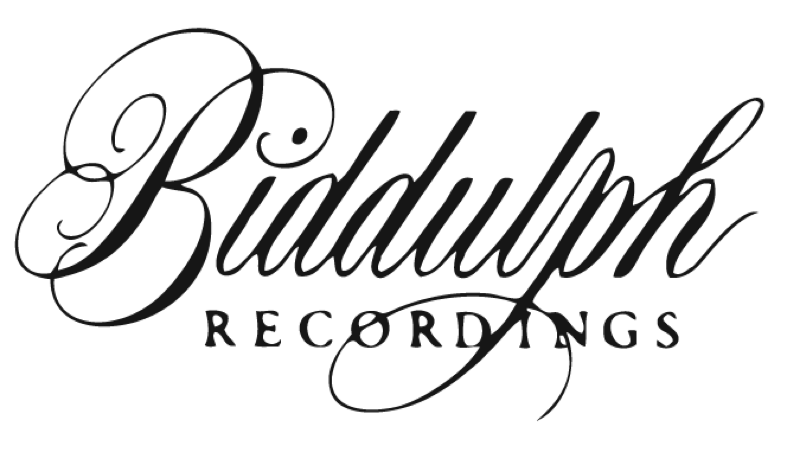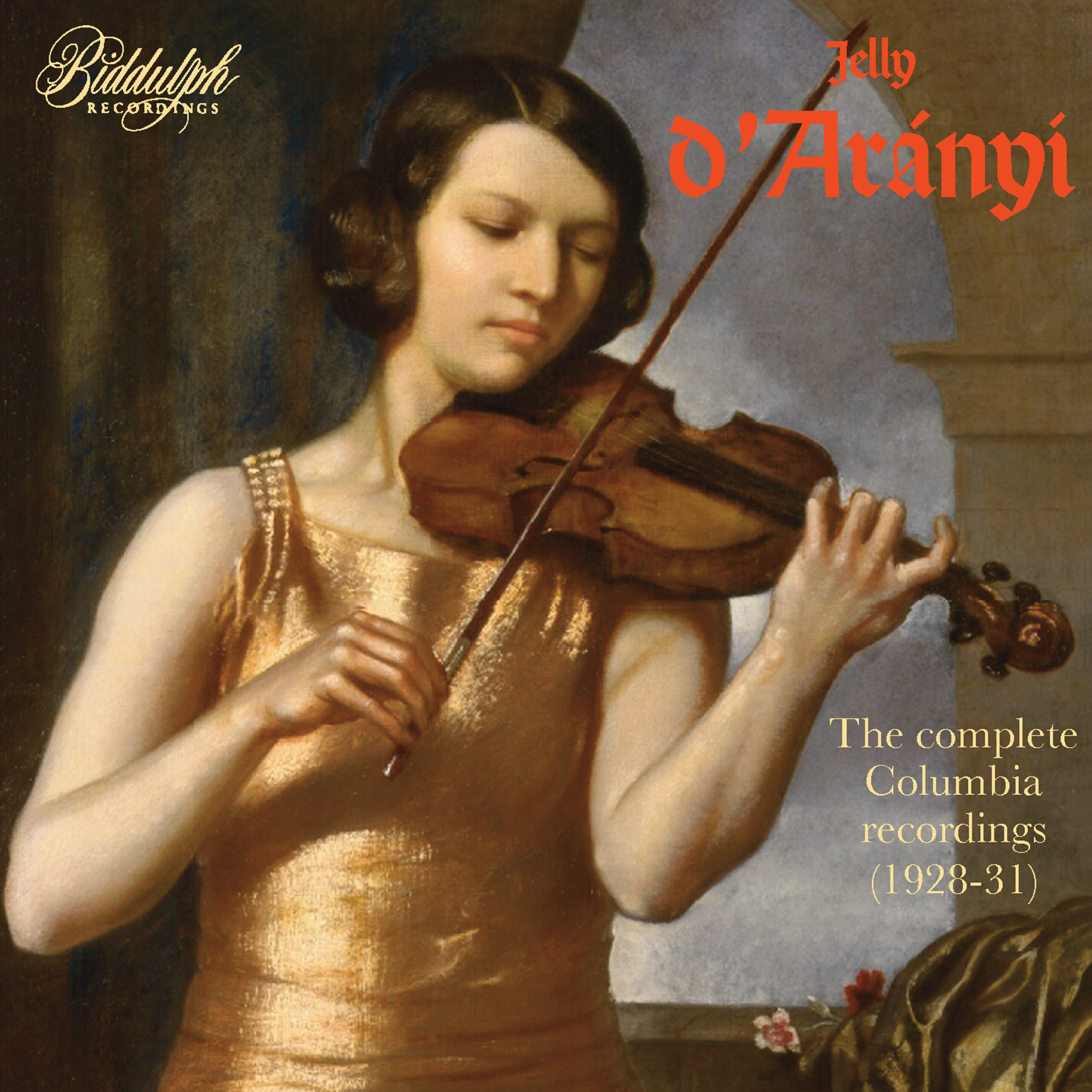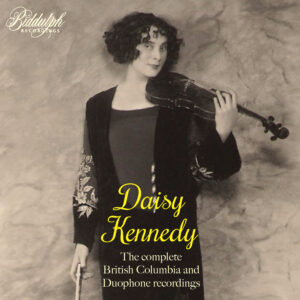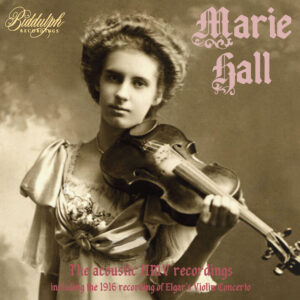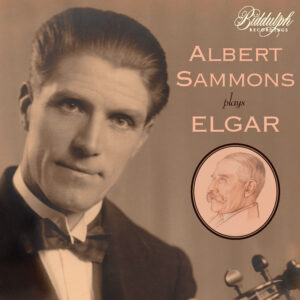Jelly d’Arányi – The complete Columbia recordings (1928-31)
Release date: 7 March 2025
BDF-ED-85063-2
“Elegance and polish”
-Music Web International
Read full review
One of the most distinctive female violin soloists of the interwar years was Jelly (or Yelly) d’Arányi, born in Budapest on 30 May 1893 and the youngest of three sisters – Adila, the eldest, was a fine violinist under her married name Fachiri but pianist Hortense, or ‘Titi’, was less well known.
It was much more difficult to get a recording contract in those days if you were a woman: a prominent player in Germany, Australian-born Alma Moodie, made no records, Marie Hall was not recorded electrically although she was one of Britain’s best fiddlers, and Isolde Menges’s studio career faded quite early. We are fortunate to have many recordings of d’Arányi but most were made for a second-rank label, Vocalion. This CD primarily features her later discs for Columbia. Sadly she was not asked to record any of the important pieces which were written for her.
Jelly d’Arányi was originally destined for the piano and gave her first concert at six; but on her eighth birthday, Adila’s former teacher Victor Herzfeld noticed her hands and declared she would make a natural violinist. Which she did, passing the Budapest Academy’s entrance test after six weeks of tuition from Adila, and studying like her sister with Herzfeld and Hubay. At ten she played part of a Spohr concerto for her great uncle Joseph Joachim, who wanted to teach her – but by the time she was old enough, he was dead. As a result, she had no tuition after the age of 14 to back up her exceptional talent.
Her first foreign concerts were given with Adila, in Vienna and Trieste in 1908; all three sisters came to Britain in February 1909, meeting Casals and Tovey – Adila and Jelly made their London début with the latter. They toured Hungary, Italy and France but became so popular in England that it was inevitable they would settle here. In 1914 Jelly was taken up by Clara Schumann’s pupil Fanny Davies, who formed a trio with her and Guilhermina Suggia. A piano quintet featured Adila and Jelly with Leonard Borwick, Rebecca Clarke (later Raymond Jeremy) and Percy Such (later Arthur Williams). In 1919 the sisters appeared in London with Ernest Tomlinson and Williams, playing Glière’s G minor Quartet and – with the addition of Alfred Hobday and Alexander Fachiri – Brahms’s B-flat Sextet.
Jelly’s first London solo recital came on 25 October 1919 at Wigmore Hall. ‘Miss Jelly d’Arányi sets us an example of what tone can and should be,’ wrote the critic of The Times. On another evening she played Elgar’s new Sonata. She struck up a duo with Ethel Hobday and in 1920 played the Beethoven Concerto for the first time, in Edinburgh. That year she also made the first of 43 Proms appearances – no interwar Proms season was complete without a performance of Bach’s ‘Double’ Concerto by the sisters Fachiri and d’Arányi.
She championed new music: Stravinsky’s The Soldier’s Tale, Ravel’s Sonata for Violin and Cello, pieces by Szymanowski (who became a friend) and the two sonatas Bartók wrote for her (the composer, smitten by her charms, often played the piano for her). Although d’Arányi did not première either Sonata, she did give the First its initial London per-formances with the composer, at the residence of the Hungarian Chargé d’Affaires on 14 March 1922 and the Aeolian Hall ten days later. In a British Music Society recital on 7 May 1923, the duo introduced the Second Sonata to London. The Tzigane which Ravel dedicated to d’Arányi in 1924, she premièred in London (with Henri Gil-Marchex at the piano) and Paris (with orchestra under Gabriel Pierné). She gave the first performances of Vaughan Williams’s Concerto Accademico (1925), Dame Ethel Smyth’s Concerto for Violin and Horn (in 1927 with Aubrey Brain) and Holst’s Double Concerto (in 1930 with Adila).
Myra Hess became her sonata partner in 1927, the year of her first American tour, and they included the new Ravel Sonata in their programmes, just beating Szigeti to the U.S. première. In 1930 d’Arányi gave a number of performances of Joachim’s ‘Hungarian’ Concerto to celebrate his centenary; and on 6 November 1931 she played the Beethoven, Mendelssohn and Brahms Concertos at Queen’s Hall with Sir Hamilton Harty conducting. A feature of the Beethoven was that she became the first to adapt the cadenzas which the composer had written for the piano version – her friend Tovey had a hand in the transcriptions. When she played Brahms’s ‘Double’ Concerto with Beatrice Harrison in 1932, Harty got her to do the big solo in Strauss’s Ein Heldenleben as well. The following year she repeated the Brahms with Gaspar Cassadó – Sir Thomas Beecham conducted – and made a concert tour of Britain’s cathedrals for charity. She did her share of Tchaikovsky and Bruch G minor Concertos, as well as the Mozart G major and D major. Ill health in the mid-1930s held up her career and the onset of arthritis led to Myra Hess terminating their duo; but in February 1938 – having allegedly been informed of the work’s existence at a spiritualist seance – d’Arányi introduced the Schumann Concerto to Britain. At the end of that year she played for the music-loving Queen. She gave many charity recitals during World War II but her career never recovered after 1945, although she was appointed CBE in 1946 and still won praise for her occasional recitals, such as one at the Wigmore Hall in November 1949.
It seems likely that being a natural, relatively untutored player who depended on being on top form, she lost her touch and did not have her sister’s reserve of technique to fall back on. Sadly, she was never comfortable with the Stradivarius which friends bought her in 1936 – and for which she gave up the Carlo Bergonzi she played in her prime (and on these recordings). She spent her last years with Adila in Florence, giving her final concert at the Castello del Trebbio in 1965 and dying on 30 March 1966. A cultured, impulsive, striking-looking woman who was fluent in four languages, Jelly d’Arányi was an intriguing mixture of intellect and temperament, a devastating performer on her good days. She was not a natural teacher like her sister Adila but her pupils found her demonstrations inspiring.
Her only concerto recordings – the Bach ‘Double’ and Mozart’s G major – were made for Vocalion, as were her exquisite violin duo discs with Adila. For Columbia she recorded short pieces and two trios with Myra Hess, Schubert’s B flat (with Felix Salmond) and Brahms’s C major (with Cassadó). To fill out the picture of her Columbia short pieces, the Mozart Concerto is included. It is a strange production, in that she was not allowed to play a cadenza, yet the ‘Haffner’ Minuet was appended as a filler. There are little unstylish slowings-down in but it is fluent playing; nicely sustained with a lot of personality in the final Rondo. Turning to the Columbias, the Vitali Chaconne is among her best records, showing the purity of her style with fine trills and the high register very well in tune. The Nardini Andante, very beautiful, is part of a spurious concerto from d’Arányi’s repertoire – as it was concocted from sonata movements, the version with piano here is relatively authentic. The distinguished Dutch accompanist Coenrad V. Bos (1875-1955) is at the piano in both pieces, as he is in the Brahms Hungarian Dance, which also commemorates her connection with Joachim. This is colourful, exciting playing. A few pieces, such as Falla’s Jota, show traces of the wide Hubay vibrato but d’Arányi finds charm for Kreisler, Kramer, Delibes, Albéniz and Gatty, delightful double-stops for Drdla and ‘Pergolesi’, and so on. The ‘Pergolesi’, a transcription of the delectable song Se tu m’ami, is actually a modern com-position by Alessandro Parisotti – at one stage, before the musicologists got to work, there were probably more misattributuons to Pergolesi than to any other composer. The Veracini and Gluck are simply lovely (British pressings of the Veracini attributed it to Mario Corti, the arranger). Both Fachiri and d’Arányi recorded pieces by Hubay, in fact d’Arányi did hers twice; and it must be said that the younger sister sounds the more authentic interpreter. Jelly d’Arányi was a famous Bach player and we catch just an echo in the central movement of the Toccata, Adagio and Fugue, arranged by Siloti. The other accompanist is also notable, Minnesota-born Arthur Oscar Bergh (1882-1962), a violinist as well as a pianist, organist, conductor, composer and recording pioneer. Like Bos he lived to be 79.
© Tully Potter
1. VITALI (arr. Charlier) – Chaconne
recorded 6 March 1929; first issued on Columbia 50267-D (matrix W 98637)
2. BACH (arr. Siloti) - Adagio
recorded 10 March 1931; first issued on Columbia 2443-D (matrix W 151412)
3. DESPLANES – Intrada
recorded 10 March 1931; first issued on Columbia 1744-D (matrix W 148027)
4. VERACINI (arr. Corti) – Grave
recorded 20 March 1929; first issued on Columbia 2092-M (matrix W 148114)
5. PERGOLESI – Arietta
recorded 10 March 1931; first issued on Columbia 2443-D (matrix W 151411)
6. NARDINI – Andante from Violin Concerto in E minor
recorded 9 February 1928; first issued on Columbia 50165-D (matrix W 98455)
7. GLUCK (arr. Kreisler) - Melodie
recorded 6 February 1928; first issued on Columbia 147-M (matrix W 145610)
8. KREISLER – Scherzo ‘in the style of Dittersdorf’
recorded 10 March 1931; first issued on Columbia 1774-D (matrix W 147931)
9. KREISLER – Rondino on a theme of Beethoven
recorded 9 February 1928; first issued on Columbia 147-M (matrix W 145629)
10. BRAHMS (arr.Joachim) – Hungarian Dance No.8
recorded 7 February 1928; first issued on Columbia 2061-M (matrix W 145620)
11. HUBAY – Poème hongrois
recorded 7 February 1928; first issued on Columbia 2042-D (matrix W 98641)
12. DELIBES (arr. Gruenberg) - Passepied
recorded 5 March 1929; first issued on Columbia 2042-D (matrix W 148026)
13. DRDLA – Souvenir
recorded 21 March 1929; first issued on Columbia 2092-M (matrix W 148115)
14. GATTY – Bagatelle
recorded 5 March 1929; first issued on Columbia 2126-D (matrix W 147939)
15. KRAMER – Silhouette
recorded 20 March 1929; first issued on Columbia 50165-D (matrix W 98639)
16. ALBÉNIZ (arr. Dushkin) - Tango
recorded 5 March 1929; first issued on Columbia 2126-D (matrix W 147932)
17. DE FALLA (arr. Kochánski) - Jota
recorded 6 February 1928; first issued on Columbia 2061-M (matrix W 145614)
18. MOZART – Minuet in G minor
recorded November 1925; first issued on Vocalion A0244 (matrix 04025)
MOZART – Violin Concerto No.3 in G, K.216
recorded November 1925; first issued on Vocalion A0242/44 (matrix 04020/24)
19. I Allegro
20. II Adagio
21. III Rondeau: Allegro
